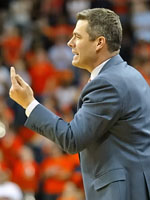 |
|
Tony Bennett |
With guard Taylor Barnette announcing his transfer out of the Virginia men’s basketball program this week, it sparked conversations throughout the fan base. The general topic: attrition under Tony Bennett. The Cavaliers have had nine players transfer during Bennett’s four-year tenure to date.
The list:
- Taylor Barnette
- Billy Baron
- John Brandenburg
- KT Harrell
- Paul Jesperson
- James Johnson
- Jeff Jones
- Will Regan
- Tristan Spurlock
The prevailing debate has become whether that is an alarming number (for varied reasons) or merely the cost of doing business in modern college basketball. It is likely a bit of both. The number is alarming in the sense that it is a big number. Nine. Pete Gillen had fewer players than that on scholarship one year. It is a fairly big number. On the other hand, transfers are just part of college basketball right now. As this CBS link indicates, more than 400 players had decided to transfer by late May. With something that normal across the Division Iandscape, it isn’t nearly as unsettling.
Besides, the attrition isn’t inexplicable. This ACC Sports Journal link, as well as many of the threads on TheSabre.com’s message boards, outlines the most common explanations for the transfers. The big two are fairly simple and far-reaching reasons: early tenure turnover (not the coach who recruited you so not comfortable) and improving talent turnover (not the playing time/role/fit you envisioned as a recruit). Those two factors are true at any program and, generally, those types of transfers happen at every program.
In each individual case at Virginia, the transfer decision isn’t alarming at all. Barnette, Baron, and Harrell wanted more playing time/different roles elsewhere, while Jones, Johnson, and Spurlock wanted more playing time/different roles and different playing styles elsewhere. Brandenburg and Regan left for reasons not solely connected to basketball. That leaves Jesperson, who is the most surprising of the group simply because he started 33 of 35 games this past season and averaged 25.7 minutes per game. In other words, playing time to date isn’t a concern there. Future playing time, however, could have been with the return of Malcolm Brogdon from injury and the ability of other players on the roster to also fill that wing role.
Of the nine players that transferred, only six were recruited to Virginia by Bennett. Jones, Spurlock, and Brandenburg committed to UVa to play for then coach Dave Leitao. Barnette, Baron, Harrell, Jesperson, Johnson, and Regan committed with Bennett at the helm. Notice any important tie between those six names?
A factor that has not been discussed much on the message boards or elsewhere that I have seen is one simple caveat to all of this: big recruiting classes. Baron, Harrell, Johnson, and Regan came to Virginia as part of a six-man class with Joe Harris and Akil Mitchell deemed “The Six Shooters” by The Daily Progress in Charlottesville. Barnette, meanwhile, joined the Hoos as part of last year’s freshman class that included Justin Anderson , Mike Tobey , and Evan Nolte . That quartet joined the same scholarship line as redshirts Teven Jones and Brogdon plus transfer Anthony Gill.
In other words, five of the six transfers that were recruited to UVa by Bennett fall into two recruiting classes. Those two classes carried 10 of the 16 players (11 if you count mid-year enrollee Teven Jones ) that committed to Virginia in Bennett’s first four recruiting classes. Arguably, the second large class occurred as a direct result of the transfers from that first six-person class, which was put together in the few short months between Bennett’s April start date and November signing day.
The exception in that first class was Baron, who joined the commitment list late and was essentially a reach or a flier pick to see what happened when he arrived at the ACC level. Interestingly, the same description applies to Barnette, who was added as a commitment late after his initial scholarship plan at Central Florida fell through. Both players are considered good or great shooters so there’s a specialty skill factor to be accounted for in their situations too.
Long story short, when Bennett arrived at UVa it was time to make the donuts. That required filling in some roster holes (see what I did there?). Bennett’s method to address that issue is to feature an initial class with a large number of recruits. There is no quicker way to reset the culture of a basketball program because half of the roster is made up of newly signed scholarship players. That approach, of course, can cut both ways in that attrition is more likely. Still, I don’t think anyone expected four of the first six signees to move on, much less in the middle of a season like Johnson and Harrell. Unfortunately, that set up a second reboot of sorts with another large recruiting class in year three (and the number in that class grew with Brogdon’s foot problem and Gill’s transfer), from which Barnette elected to transfer.
Simply put, four of the six transfers that can be tagged to Bennett directly came from that first recruiting class. That skews the rate. The program’s overall trajectory, meanwhile, continues to point up with four straight seasons of better records, back-to-back postseason appearances, and improving recruiting rankings. With that under consideration, the transfer attrition isn’t alarming as much as it is part of what it takes to make the donuts.



